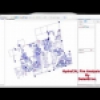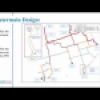Water Distribution Systems Master Planning With HydraCAL
Master planning study for water distribution systems is a very complicated and lengthy process. It often takes months if not years, to finalize. By the time it is done, the system under study has changed so much that most of system parameters should be updated. This and growth in the system are the main reasons why these type of wide range system planning studies are often updated every 5~10 years.
The process starts by updating the system current and future demands. It also often include a model calibration study to make sure the computer model that is being used in the planning is up-to-date and it is closely resembling the reality.
The next main steps is to look into the system capacities and compare them with the future demand requirements, and find out the system deficits. These studies are mainly undertaken to answer the following questions:
- Which parts of the system need upgrading?
- What new facilities are required?
- How and when these system upgrade and rehabilitation projects have to take place.
HydraCAL could help to find optimized answers for every one of these questions. Using system wide, full range operational simulation, allows you to find the weak links of your water distribution system. For instance, you can find out which pipes are wasting higher energy. In other word, the pipes’ average headloss is high; this happens whenever the pipe is old or the pipe flow does not match its diameter. Therefore this pipe could be a good candidate for rehabilitation; You may also find out which pumps are constantly running out of their curves (i.e., operating far from their optimized point either to the right or to the left) and in which year or under which demand conditions these problems happen.
What is system wide, full range operational simulation?
Traditionally, water distributions systems are only evaluated under limited conditions, for instance average or maximum day demands. These kind of modeling forces the system boundary conditions (reservoirs, pumps, valves, …) to specific settings. This means, a certain number of pumps in a pump station might have been turned on/off to satisfy the demand condition under simulation while the pump station’s firm capacity or system critical condition might be far from these predefined settings. Additionally, the system control narratives are often designed to satisfy certain demands and they are constantly being updated by changes in the demand conditions. This is why they should not be seen as something fixed in the system neither they should be trusted for designing and/or master planning studies in which the goal is to satisfy the future conditions with lots of uncertainties.
In other words, even optimized settings and control narratives do not necessarily show how your system might perform or might be utilized under future conditions and demands. Therefore, it makes more sense to simulate your system with all possible boundary condition combinations, rather than those set by the control narratives.
Let’s look at a real example. The following figure shows the watermains headloss under future (2031) maximum day demand (MDD) while the recommended system narratives are used to control various facilities. The model shows almost all of the watermains are performing in an acceptable range of headloss (i.e., in this particular system, less than 1.5 m head/km).
The problem with this approach is that we do not know how the demand will changes in future, and how the control narratives would adapt to it therefore, relying on this estimates could be misleading. The better approach to see the performance of your system is to look at the watermain average headlosses under all possible operational scenarios (i.e., all combinations of various pumps, reservoir water levels, key valves, etc.). If the headloss for a particular watermain is by average over your headloss limit, therefore it is safe to assume that this watermain would face capacity issue in future and you should plan accordingly.
Let’s this time look at the headlosses for the same system while all possible system scenarios are simulated using HydraCAL. As you may see, the number of watermains with the capacity issue is increases. By looking at this figure, you could easily infer that there is a capacity limitation to transfer water from the pump station located in the south, toward north and you should plan to increase your south-north corridor transferring capacity. You would have not been able to recognize this issue if you were using the traditional approach and were only looked at MDD results. This is why we believe simulating the performance of your system under full range of operational scenarios should replace the traditional approach which only looks at limited scenarios.
Using HydraCAL in this simple project helps to easily recognize the problem which was the lack of south-north transfer capacity. In this project, we only focused on part of a zone to make the text short, but the same simulation results could be used to look at other part of the system and find out whether they have any issues. You could record every single pump performances and investigate if they have efficiency issues. The reality is that with this kind of simulation you have the full package to investigate the performance of every single system components.
After finding the issues you could come up with solutions and evaluate them all in HydraCAL. For instance, you could add a watermain to satisfy the transfer requirement. And hit the run button to re-evaluate your system to see if that extra watermain would solve the issue or not and how it will impact other variables such as the pressures, and fire flow in your system.
For this particular case study which includes 50,000 pipes we evaluated 15,000 different scenarios. You might think this would take forever to run but reality is that the entire simulation only took around 15 min. Please keep in mind that this is an all pipe model, which you don’t necessarily need in master planning studies. HydraCAL uses a specific algorithm that utilizes all of your computers CPUs automatically without the need for going through a complex procedure to set up. This will be my next blog topic, so please stay tuned.
Ehsan Roshani Ph.D., P.Eng.







